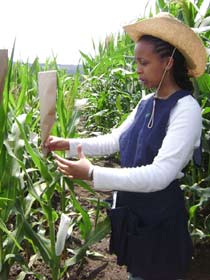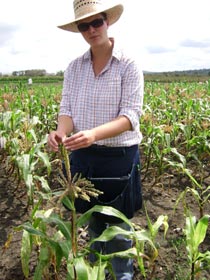CIMMYT E-News, vol 5 no. 5, May 2008
 CIMMYT is adapting an advanced technology—the doubled haploid approach—to develop inbred lines of tropical maize for sub-Saharan Africa. It promises to reduce costs and speed the arrival of better-adapted maize for resource-poor farmers in the world’s toughest environments.
CIMMYT is adapting an advanced technology—the doubled haploid approach—to develop inbred lines of tropical maize for sub-Saharan Africa. It promises to reduce costs and speed the arrival of better-adapted maize for resource-poor farmers in the world’s toughest environments.
CIMMYT scientists have begun developing drought tolerant varieties of tropical maize for places like sub-Saharan Africa using a high-tech approach—known as doubled haploids—previously applied principally by commercial seed companies working mostly on temperate maize.
“Haploid” refers to the number of chromosomes in a reproductive cell, like sperm or ovum. In grasses like maize, the reproductive cells—pollen and ovules—contain half the chromosomes of a full-grown individual. Fertilization joins the genetic information from the two parents, and offspring carry paired sets of chromosomes, reflecting the diversity of each parent.
“Maize breeders working on hybrids—the most productive type of maize variety and the one marketed by most seed companies—must at some point create genetically-stable and pure lines of desirable, individual plants, for use as parents of hybrids,” says CIMMYT maize physiologist Jose Luis Araus. Conventionally, breeders get the lines by repeatedly fertilizing selected, individual maize plants with the plant’s own pollen. The process requires expensive field space, labor, and time—normally, seven or more generations, which represents at least three years, even in settings where it’s possible to grow two crops per season.
Purer, faster, cheaper
In the latter part of the 20th century, crop scientists developed a quicker, cheaper path to genetically-uniform parent lines—though a technically intricate method. The first step involves crossing normal maize with special maize types called “inducers,” whose pollen causes the normal maize to produce seed containing haploid embryos. The haploid embryo carries a single set of its own chromosomes, rather than the normal paired sets. The embryos are planted, and subsequent treatment of the seedlings with a particular chemical causes them to make “photocopies” of their haploid chromosomes, resulting in a fertile plant endowed with a doubled set of identical chromosomes and able to produce seed of 100% genetic purity. “The actual treatment, as well as getting from the embryo to a reasonable amount of seed of the pure line, is very complicated,” says Ciro Sánchez Rodríguez, CIMMYT technician in charge of doubled haploid field trials, “but when the process is perfected, it only takes two generations—about one year—and the logistical advantages are tremendous.”

First extensive use in the tropics
CIMMYT is implementing the doubled haploid technology on a research station in Mexico, using drought tolerant plants adapted to sub-Saharan Africa. “CIMMYT’s use of the practice is another example of how we put advanced technologies at the service of disadvantaged, small-scale farmers,” says Araus. “Among other things, this represents a significant opportunity to increase the availability of improved, drought tolerant maize varieties for sub-Saharan Africa,” he says.
Commercial seed companies in Europe and North America have been the main users of the doubled haploid technology, and the inducer genotypes available are of temperate adaptation. “The inducers perform very poorly in the tropical conditions of our Mexico stations,” says Vanessa Prigge, a PhD student from the University of Hohenheim working at CIMMYT to perfect the technique. To generate inducers that work better in tropical settings, Prigge and colleagues are crossing temperate inducers from Hohenheim with CIMMYT maize from Mexico, Kenya, and Zimbabwe. “We expect to have tropical versions of the inducers in a couple years,” she says.
Reaching farmers’ fields
Maize lines from this work will be used initially in the Drought Tolerant Maize for Africa (DTMA) and the Water Efficient Maize for Africa (WEMA) projects.
“This is a very exciting technology,” says Aida Kebede, an Ethiopian PhD student from Hohenheim helping to establish the doubled haploid technology at CIMMYT. “It holds the key to addressing more quickly the persistent problems of African maize growers: drought, disease pressure, and low productivity. I’m happy to contribute!”
 Climate adaptation and mitigation
Climate adaptation and mitigation 
